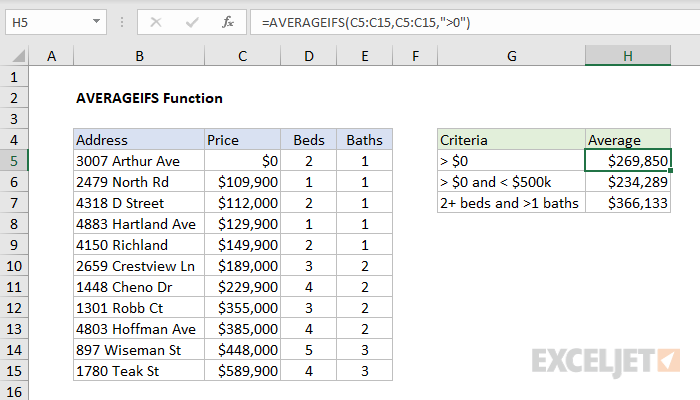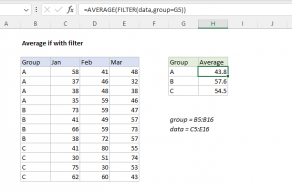Purpose
Return value
Syntax
=AVERAGEIFS(avg_rng,range1,criteria1,[range2],[criteria2],...)- avg_rng - The range to average.
- range1 - The first range to evaluate.
- criteria1 - The criteria to use on range1.
- range2 - [optional] The second range to evaluate.
- criteria2 - [optional] The criteria to use on range2.
Using the AVERAGEIFS function
The AVERAGEIFS function calculates the average of cells in a range that meet multiple conditions, referred to as criteria. Each condition is provided with a separate range and criteria. To define criteria, AVERAGEIFS supports various logical operators (>,<,<>,=) and wildcards (*,?,~). The AVERAGEIFS function is widely used in Excel and can be used to average cells based on dates, text values, and numbers. However, the syntax used to apply conditions is a bit tricky because it is unusual in Excel. See below for details.
Key Features
- Calculates averages based on multiple conditions
- Supports logical operators (>, <, >=, <=, <>, =) and wildcards (*, ?, ~) for flexible matching
- Automatically excludes empty cells from the average calculation (even when criteria match)
- Only cells that meet all conditions are included in the final average (uses AND logic).
- Returns #DIV/0! error if no cells meet the specified criteria.
- Works in Excel 2007 and all later versions.
Unlike most other Excel functions, AVERAGEIFS requires actual ranges for average_range and all criteria_range arguments. If you try to use an array, Excel will not let you enter the formula.
Syntax
The syntax for the AVERAGEIFS function depends on the criteria being evaluated. Each separate condition will require a range and criteria. The generic syntax for AVERAGEIFS looks like this:
=AVERAGEIFS(avg_range,range1,criteria1) // 1 condition
=AVERAGEIFS(avg_range,range1,criteria1,range2,criteria2) // 2 conditionsThe first argument, avg_range, is the range of cells to average, which should contain numeric values. The second argument, range1, is the range to which the first condition should be applied. The third argument, criteria1, contains the condition that should be applied to range1, along with any logical operators. Additional conditions are applied by providing additional range/criteria arguments.
Applying criteria
The AVERAGEIFS function supports logical operators (>,<,<>,=) and wildcards (*,?) for partial matching. Because AVERAGEIFS is in a group of eight functions that split logical criteria into two parts, the syntax is a bit tricky. Each condition requires a separate range and criteria, and operators need to be enclosed in double quotes (""). The table below shows some common examples:
| Target | Criteria |
|---|---|
| Cells greater than 75 | ">75" |
| Cells equal to 100 | 100 or "100" |
| Cells less than or equal to 100 | "<=100" |
| Cells equal to "Red" | "red" |
| Cells not equal to "Red" | "<>red" |
| Cells that are blank "" | "" |
| Cells that are not blank | "<>" |
| Cells that begin with "X" | "x*" |
| Cells less than A1 | "<"&A1 |
| Cells less than today | "<"&TODAY() |
Notice the last two examples use concatenation with the ampersand (&) character. When a criteria argument includes a value from another cell, or the result of a formula, logical operators like "<" must be joined with concatenation. This is because Excel needs to evaluate cell references and formulas first to get a value, before that value can be joined with an operator.
Examples
In the example shown, the formulas in H5:H7 are:
=AVERAGEIFS(C5:C15,C5:C15,">0")
=AVERAGEIFS(C5:C15,C5:C15,">0",C5:C15,"<500000")
=AVERAGEIFS(C5:C15,D5:D15,">=2",E5:E15,">1")
These formulas return the average price of properties where:
- prices are greater than zero
- prices are greater than zero and less than $500,000
- properties have at least 2 bedrooms and more than 1 bathroom
Double quotes ("") in criteria
In general, text values in criteria are enclosed in double quotes (""), and numbers are not. However, when a logical operator is included with a number, both the number and the operator must be enclosed in quotes. Note the difference in the two examples below. Because the second formula uses the "greater than or equal to" operator (>=), the operator and number are both enclosed in double quotes.
=AVERAGEIFS(C5:C15,D5:D15,2) // 2 bedrooms
=AVERAGEIFS(C5:C15,D5:D15,">=2") // 2+ bedrooms
Double quotes are also used for text values. For example, to average values in B1:B10 when values in A1:A10 equal "red", you can use a formula like this:
=AVERAGEIFS(B1:B10,A1:A10,"red")
Multiple criteria
Enter criteria in pairs [range, criteria]. For example, to average values in A1:A10, where B1:B10 = "A", and C1:C10 > 5, use:
=AVERAGEIFS(A1:A10,B1:B10,"A",C1:C10,">5")
Value from another cell
A value from another cell can be included in criteria using concatenation. In the example below, AVERAGEIFS will return the average of numbers in A1:A10 that are less than the value in cell B1. Notice the less than operator (which is text) is enclosed in quotes.
=AVERAGEIFS(A1:A10,A1:A10,"<"&B1) // average values less than B1
Wildcards
The wildcard characters question mark (?), asterisk(*), or tilde (~) can be used in criteria. A question mark (?) matches any one character and an asterisk (*) matches zero or more characters of any kind. For example, to average values in B1:B10 when values in A1:A10 contain the text "red", you can use a formula like this:
=AVERAGEIFS(B1:B10,A1:A10,"*red*")
The tilde (~) is an escape character to match literal wildcards. For example, to match a literal question mark (?), an asterisk (*), or tilde (~), add a tilde in front of the wildcard (i.e. ~?, ~*, ~~).
Note: the order of arguments is different between AVERAGEIFS and AVERAGEIF. The range to average is always the first argument in AVERAGEIFS.
Notes
- All ranges must be the same size, or AVERAGEIFS will return a #VALUE! error.
- Only values that meet all conditions will be included in the final result.
- AVERAGEIFS will not include empty cells in the average, even when criteria match.
- TRUE and FALSE values are ignored when calculating an average.
- AVERAGEIFS will return a #DIV/0! error if no cells meet criteria.
- AVERAGEIFS requires a range, you can't substitute an array.
- Logical operators and text values should be enclosed in double quotes ("").
- AVERAGEIFS supports wildcards but is not case-sensitive.



























